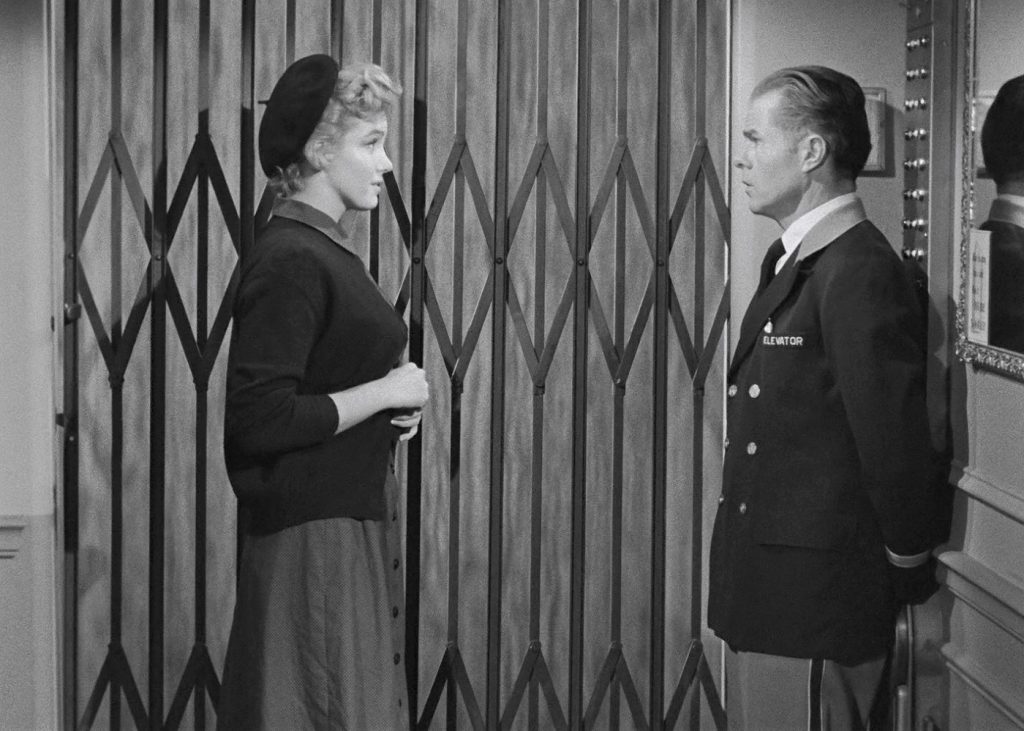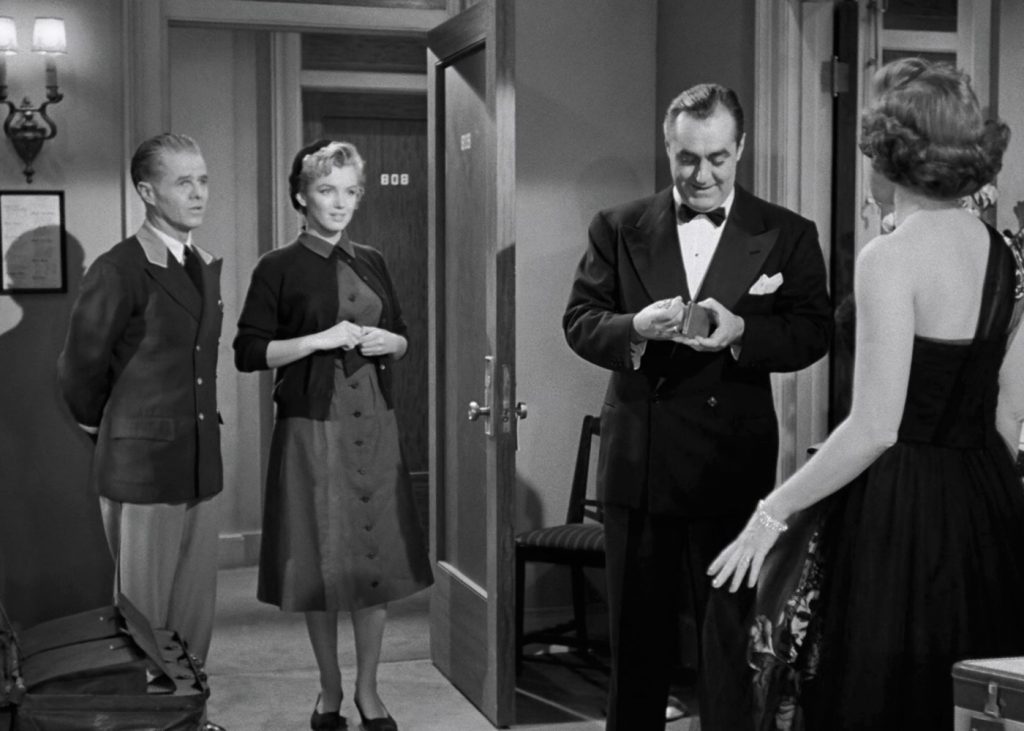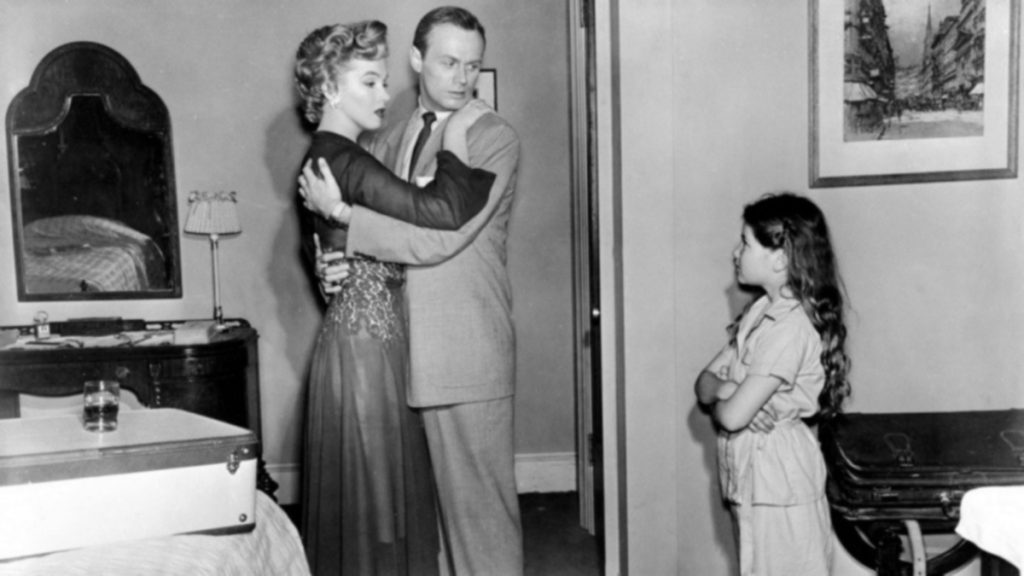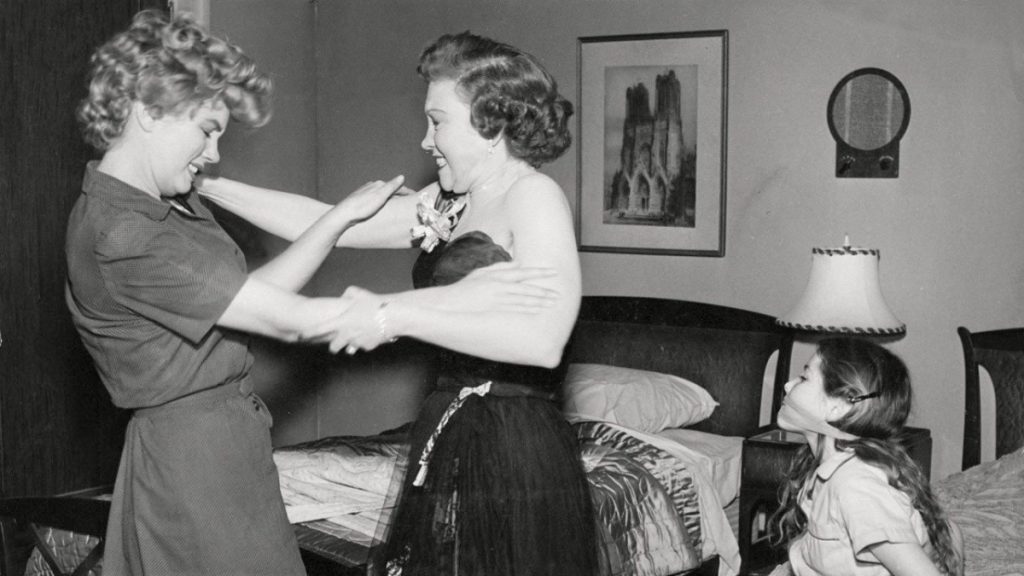Don't Bother to Knock
18 July 1952
Marilyn Takes the Lead in a Drama

Nell Forbes appears to be just another normal young woman when she enters the lobby of the McKinley, a residential hotel in New York City. Her slightly hesitant behavior indicates she’s in an unfamiliar environment but indicates nothing else. She is wearing a drab, ordinary dress, sweater and low heels. A small, dark beret sits precariously on the back of her head and she clutches a small purse. Her legs are bare. She has a pretty face, appears healthy, even happy. She smiles at her Uncle Eddie, the hotel’s elevator jockey, when he approaches and then leads her into the elevator, revealing the back of her wrinkled dress: her bus ride to the McKinley must have been lengthy. During their elevator ride to the eighth floor where Nell will babysit a little girl, her conversation with her uncle combined with the sadness in her large, liquid eyes suggests that she might be a little troubled.
Meanwhile, Lyn Lesley, a sultry chanteuse who appears nightly in the McKinley’s lounge confides in the bartender that she recently ended her six month relationship with Jed Towers, an airline pilot, who is flying in from Chicago. When he arrives, Jed confronts her: he wants Lyn to reconsider her decision. She admits to him that they were lovely together, fifties code for the sex was good; but even so, she is still finished with him. He is unromantic, cynical about love and lacks an understanding heart, something she asks for in a man. Jed displays his callous nature with Janie, the pleasant hotel photographer who simply wants to photograph the happy couple and then sell Jed a personalized knickknack.
His treatment of Janie, downright rude and unnecessarily surly both before and after she snaps the photograph, only strengthens Lyn’s resolve to end their relationship. After she advises Jed to fly back to Chicago, find another bar and girl, he finally gets the message: they are finished as a couple. He retreats to his room.
Once there, wounded, angry and frustrated, stung by Lyn’s rejection and criticism, he produces, without hesitation, a little black book and then a bottle of rye. He apparently intends to assuage his anger and medicate his pain with booze and sex; he intends to get even. He thumbs through and then discards his black book. Why he chooses not to order one of the female pain pills contained in his directory of past conquests is never revealed but doubtful it’s an attack of conscience.
Shortly he spots Nell, visible in her window across a courtyard, dancing seductively; she is dressed in a negligee. Using the floor plan of the hotel hanging on his room’s door, Jed deduces that Nell is in Room 809. He telephones her and introduces himself as Billy. He wants to get together, he says, and spin a few stories. Stories are not exactly what Jed intends to spin.
Nell’s interaction with Billy, who brings along his bottle of rye, is initially friendly and slightly flirty; but it soon devolves into a situation of delusion colliding dangerously with reality. Billy, who eventually reveals that his true name is Jed, intends to seduce Nell; and she seems just like the right woman to use as a sexual pain pill―young, beautiful, voluptuous, easy perhaps―until she learns that Jed is a pilot. Then her entire demeanor changes. She becomes distant and saddened. Nell was once engaged to a pilot, gave herself to him sexually; but he was killed when his airplane crashed in the Pacific Ocean.

In Nell’s distressed state, resulting from the memory of this catastrophic loss, she begins to confuse Jed with Phillip, her dead fiancé. At first Jed is confused and slightly bemused: he doesn’t exactly know what to make of Nell. Then Bunny, the little girl Nell is babysitting, appears.
Bunny is an irritant, the reality that interferes with Nell’s delusion and her miraculously resurrected Phillip. This conflict between delusion and reality causes Nell to become angry and react negatively to the child. In the movie’s pivotal scene, as Bunny leans precariously out a window, eight stories above the street, Nell begins to look at her menacingly and places her hand in the center of the child’s back, a suggestion that Nell is thinking about shoving Bunny to her death; but an elderly hotel guest across the courtyard, a few floors below, spots Bunny in that dangerous position and screams. Her screams alert Jed so he rushes to the window, grabs Bunny and pulls her back inside. Afterwards, with Bunny put back to bed, Nell begins to fade in and out of reality like a radio that can’t quite hold a station. Jed wants to leave but Nell can’t allow that to happen so she wraps her arms around his neck with the intention of kissing him and keeping him in the room, with her. When he grabs her wrists to remove her arms, he feels and then sees the scars left by a suicide attempt.
Uncle Eddie, who won’t like a man being in the room with Nell, arrives for a visit; so she hides Jed in the bathroom. Her uncle’s visit begins amicably enough but ends violently because Nell thinks he is now trying to come between her and Phillip. When Eddie realizes that Nell has a man hidden in the bathroom, he tries to open the door so she grabs a nearby floor standing ash tray and bangs Eddie in the head.
Mrs. Jones, Bunny’s mother telephones from the hotel dining room, where she is attending an awards banquet with the husband, and speaks to Nell while Jed attends to Eddie’s head wound. The strange conversation with Nell doesn’t alert Mrs. Jones to the possibility that her daughter might be in danger so mom returns to the dining room. The elderly woman who screamed in the earlier scene arrives with her husband to pound on the door: she wants to know what is going on. Uncle Eddie, fearing he will lose his job in the hotel, convinces Jed not to cause trouble and then hides in the closet.
As Nell speaks to the old couple, Jed sees his chance to escape and exits through Bunny’s bedroom. Not aware that Nell has bound and gagged the little girl, he asks Bunny if she is sleeping. No, she is laying quietly, fearfully in the dark. The elderly woman and her husband observe Jed’s hasty exit and departure, however, and due to some vague, misleading statements by a confused Nell, they conclude that Jed was in the room trying to molest her. They notify the front desk who in turn notifies the house detective.
Once again in the hotel bar with Lyn, Jed recounts the night’s events. This conversation, the way Jed speaks about Nell begins to soften Lyn: she perceives a change in his attitude. Suddenly, Jed realizes that Bunny was laying on the wrong bed. So the now good Samaritan Jed hurries back to room 809 only to find Nell embroiled in a fight with Bunny’s mother. Jed separates the combatants and forcefully throws Nell to the floor, where she remains momentarily, crumpled and defeated, sobbing.
Eventually, she gets to her feet; but she is dazed and confused, apparently in more pain than she can endure. Her eyes glassy with tears, she finds her way to the hotel lobby and the gift counter located there. From a display rack, she takes a box of razor blades and walks, almost staggers across the lobby, where she leans against the far wall. There is desperation and panic on her face, pain in her eyes. Nell is prepared to yet again slash her wrists but Lyn arrives to stop her. Meanwhile a large crowd has gathered. Jed pushes his way through the startled but curious onlookers and convinces Nell to give him the razor blade. He then sends the crowd packing.
Jed attempts to penetrate Nell’s delusion by asking her to describe Patrick. What color were his eyes, his hair? Nell appears to grasp what’s happening to her when Jed tells her that Lyn is his girl, that he’s in love with her. He tells Nell bluntly that he is not Patrick; Patrick is dead. Finally, two New York police officers appear and lead Nell away, to where is not revealed. Lyn now sees Jed differently: he actually has a heart and a soul and cares about someone other than himself. Maybe they do have a future after all. Maybe they can once again be lovely together.
Before I get too deep into my complaining and criticizing, allow me to go on record as saying that I like Don’t Bother to Knock. It is an odd movie, based on a popular novella written by Charlotte Armstrong and entitled Mischief, originally published in 1950. The source material’s title is cleverly referenced in the movie when Uncle Eddie prepares to leave after his first visit to room 809 and he asks Nell to avoid any additional mischief. Also, ironically, Nell’s last name in the novella is Munro. Chilling. Maybe Marilyn was destined to play the part of Nell Forbes. British director, Roy Ward Baker, commented years later: Marilyn’s background fitted and I think she knew what she was talking about. I think that’s why she―or whoever it was discovered this book―she probably thought ‘That’s for me’.’
Our odd movie suffers from a foundational deficiency. In my opinion, the movie is just not long enough. This foundational deficiency creates an overall structural weakness. We can all agree, I believe, that our movie is a psychological character study. In terms of real action, there isn’t any. But with the running time of a mere one hour and sixteen minutes, what actually happens in Don’t Bother to Knock, in Nell’s case, a psychological regression, and Jed’s case, a psychological progression, happens rather quickly, nearly at the speed of light. In the course of one short evening, Jed, who intended to engage Nell in some horizontal grunting, goes from being a cynical, angry, self-centered man who accuses Lyn of just wanting the security of a wedding ring, to being an considerate man with an understanding heart who loves Lyn and intends to help Nell overcome her psychological problems. In his scenes with Lyn prior to meeting Nell, Jed doesn’t display any sort of conflict within himself. In fact, he defends his attitude. Yet, we are asked to believe that he does a complete personality about-face in the span of a few short hours, experiencing a magical, light filled transfiguration.
Additionally, for a patient recently released from a hospital where she was treated for three years, Nell’s recovery is certainly a fragile one. Just the sound of a distant airplane and the appearance of a stranger who is a pilot triggers her regression into a dangerous delusion. If Patrick’s death was a recent trauma suffered by Nell for which she was receiving treatment as an out-patient, I might just believe her reaction to the airplane overhead and Jed. Maybe some additional back-story, a couple of flashbacks and some additional scenes providing some additional character development might have helped me believe and accept the character’s transformations. As it is, it’s just not plausible. Apparently the producers did not want to invest enough time or money to create some plausible character development. I believe in the movie business that is called character arc. In the case of Jed, it’s not so much an arc as it is a shot to the moon!


I cannot agree with some reviewers who consider Don’t Bother to Knock a film noir. Apparently any movie filmed in black and white that doesn’t fall into an obvious category gets put into a sort of film noir waste basket. I think the movie suffers from a fundamental identity confusion, though. Is the movie about Nell and her psychological regression or is the movie about Jed and his psychological progression, leading to his reunion with his girlfriend, Lyn? Admittedly, dual plot lines are often successfully interwoven in movies and I’m not suggesting that our putative film noir is completely unsuccessful. But in my opinion, neither plot line gets a sufficient amount of attention due to the movie’s length: it attempts to do too much too quickly. This results in the forced transformation of Jed and an equally forced, rapid regression of Nell; and despite Uncle Eddie’s statement that her doctor’s said Nell was cured, she obviously was not. Revealed by the lies she quickly fabricates during her flirtations with Jed, Nell is obviously a clever young woman. Maybe she cleverly fooled her doctors in Oregon.
We’ll never know. Just like we will never know what happens to Nell. The unsatisfactory ending finds Jed reunited with Lyn, the real goal of the movie it seems, while young Nell, a sad and broken woman, led away by two uniformed officers of the NYPD, is just one of several loose threads left dangling. What happens to Bunny? What happens to Uncle Eddie? The hotel cop suggests that Eddie has a lot to answer for but we never find out exactly what.
While Don’t Bother to Knock suffers from some obvious deficiencies, the cinematography and musical score are not among them, although a few of the cuts are stark. The hotel setting contributes to a certain claustrophobic feeling that metaphorically represents Nell’s past and her drab clothes symbolize Nell’s drab life; but it’s the uniformly fine performances by all the actors that rescue an otherwise weak script and the equally weak dialogue.
Donna Corcoran as young Bunny Tuttle and Elisha Cook, Jr., as Uncle Eddie, are excellent in their supporting roles. Jim Backus and Lurene Tuttle are believable as Bunny’s well-adjusted and obviously happy parents. The legendary Willis Bouchey portrays the bartender named Joe with his usual flair and ease. Are all bartenders everywhere named Joe?
Anne Bancroft’s appearance as the beautiful Lyn represents her screen debut and obviously she does a fine job with the character, delivering a natural, unforced performance. She certainly looks like a sultry bar room singer. Apparently afflicted with a weak singing voice, however, the movie’s producers forced her to pantomime the singing of Eve Marley.
Richard Widmark, perpetually stern-faced with a visage suggesting he’s just encountered a pungent, nasty smell, does a better than commendable job with Jed, considering the difficult task he was given. I believe, given more time to develop the character, given more material, his performance might even have been remarkable. He almost, but not quite, convinces me that his rejection by Lyn, combined with his odd encounter with Nell, could actually transform an absolute lout into a wonderful, sensitive man. But, alas, he comes up a bit short; but I must recognize that his lack of success is not totally his fault. After all, he can only be as good as the material and the character he is given to portray; and that fact leads me smoothly to Marilyn’s performance.


If playing Nell Forbes gave Marilyn any pause or concern, because of the mental illness in her own family and her disturbed mother, such was not revealed by her. Similarly, if Marilyn prepared for or created the character of Nell by channeling memories of how her mother behaved, as many reviewers and commentators suggest, that tactic was not revealed by her either. But then, finding any confirmation from Marilyn that she consciously emulated her mother in any form or fashion in her portrayal of Nell would be a surprise. Always the essence of discretion regarding her personal life, Marilyn kept most of her thoughts relating to her family unexpressed and she seldom spoke about her mother.
By 1952, Marilyn had been under the guidance of drama coach, Natasha Lytess, for four years and for one year, she had been a student of Michael Chekhov, the nephew of Russian playwright Anton Chekhov. Undoubtedly, she was already being influenced by Konstantin Stanislavski and his system, even though her introduction to the method of Lee Strasberg and his revered Actor’s Studio in New York City would not occur for a few years yet. Therefore, mannerisms displayed by Marilyn’s mother might have found their way into the character of Nell, assuming Marilyn actually observed her mother in a situation with circumstances similar to Nell’s. Keep in mind, Marilyn wasn’t with or around her mother that frequently. Let’s say, then, the possibility that Marilyn used her mother as a template for Nell is a definite maybe. It is more likely, I think, that Marilyn used memories of her own unhappy and sometimes grim childhood to create the morose, the confused and dreamy sadness that Nell transmits. Unlike Nell, however, Marilyn loved and adored children and the manner with which she had to treat Bunny was probably difficult for her. Adhering to her usual reticence, Marilyn never said so.
The odd debate regarding Marilyn’s acting talents and skills rages, even now, fifty-three years after her death. She undeniably stands alone as the one actress who generated radically disparate opinions among professional critics, then and now, and among her peers, the ones who attempted to direct her and act with her, regarding her talent and her technical abilities. Anne Bancroft felt this way:
It was a remarkable experience. Because it was one of those very few times in all my experiences in Hollywood when I felt that give and take that can only happen when you are working with good actors. There was just this scene of one woman seeing another woman who was helpless and in pain, and she was helpless and in pain. It was so real, I responded. I really reacted to her. She moved me so that tears came into my eyes. Believe me, such moments happened rarely, if ever again, in the early things I was doing.
Oddly enough, Mr. Widmark did not share Anne Bancroft’s opinion of Marilyn’s acting abilities:
She couldn’t act her way out of a bag, but she became an icon because something happened between her and the lens, and no one knows what it is. The minute she hit the screen everyone else was gone … We had a hell of a time getting her out of the dressing room and on to the set. At first we thought she’d never get anything right … and when we looked at the rushes she had the rest of us knocked off the screen!
And finally, our good friend Bosley saw Marilyn’s performance this way:
To be sure, the role is one that Bette Davis or even Olivia DeHavilland might have a little trouble getting over without a running start, it being the role of a young lady whose mind is drifting in cuckoo-land when she comes to do a job of baby-sitting for some strange people in a hotel … It requires a good deal to play a person who is strangely jangled in the head. And, unfortunately, all the equipment that Miss Monroe has to handle the job are a childishly blank expression and a provokingly feeble, hollow voice. With these she makes a game endeavor to pull something out of the role, but it looks as though she and her director, Roy Baker, were not quite certain what … All in all, Miss Monroe needs much more practice than she shows in Don’t Bother to Knock. This is said with full regard for that petition, but we think you and she should be told.
Thank you, Mr. Crowther for “telling” us and I’m sure Marilyn got the message.
Don’t Bother to Knock was Marilyn’s thirteenth movie since her co-starring role in 1948’s Ladies of the Chorus, and her sixteenth movie overall. Her roles in the other twelve movies were either walk-on parts, brief speaking parts or small but essential character parts in the three relatively significant movies contained in her impression trilogy. Before Zanuck assigned Marilyn the role of Nell Forbes, the studio head required a screen test, which apparently convinced him that Marilyn could deliver the character. No doubt, Marilyn understood the importance of the part; and the fact that she prepared assiduously with Natasha Lytess is obvious in her performance.
On the Clash By Night DVD during a commentary track, Peter Bogdanovich remarks that during her portrayal of Peggy in that movie, Marilyn never hits a false note. Likewise, she never hits a false note as Nell Forbes, either. A young woman constricted by an oppressive past that she wants to escape, Nell’s desperation is obvious in her eyes. Marilyn is particularly good in the scene where she meets Bunny and her happy parents. Marilyn plays Nell as nervous but congenial. The babysitter is all smiles when Bunny introduces herself but says nothing; and yet there is something slightly odd and forbidding in the furtive way Nell watches and looks at everyone, holds her arms close to her body, her hands close to her waist as she fumbles nervously with the small purse. But it is when she is alone with Bunny that Marilyn gently reveals a truly odd aspect of Nell as she sits rigidly at the end of Bunny’s bed, reading a story with a flat, perfunctory, emotionless voice, an interaction with Bunny that is devoid of anything remotely maternal or remotely friendly. Marilyn convinces me that Nell is completely disinterested in Bunny and therein rests her true pathology. In the end, her delusion shattered when Jed hurls her to the ground, Marilyn portrays Nell like a lost woman who is feeling such intense pain, death is the only medication available.
Was Marilyn’s performance created in a vacuum? You would assume that her director, Roy Ward Baker, offered Marilyn some direction even though she didn’t always follow a director’s guidance. She was headstrong, came to the set with a concept of the character and relied heavily on multiple takes to develop and find the character. George Cukor commented on more than one occasion that Marilyn really couldn’t be directed—she could only be produced. He also admitted this: left to her own concepts and ideas, her way of searching for the character, she invariably found something unique and interesting. In the case of Don’t Bother to Knock, Baker shot all the scenes in sequential order and usually printed the first take, frustrating Marilyn’s normal way of working, which makes her performance even more remarkable. The restraint, the nuance of her performance is lost on some and that is also remarkable.
Finally, and in closing, I’m not exactly sure what Bosley Crowther was trying to say with his snide remark about Marilyn’s childishly blank expression and a provokingly feeble, hollow voice. I’ll speculate, in his view, a person who is strangely jangled in the head must overtly demonstrate their jangled psychology which, of course, happens when Uncle Eddie gets knocked in the head. I’m reminded of a scene from One Flew Over The Cuckoo’s Nest in which McMurphy attempts to convince Dr. Spivey that he is insane. The doctor thinks McMurphy is just faking to avoid work. After weeks of observation, Dr. Spivey is not convinced that his patient is mentally ill. McMurphy makes a funny noise followed by a funny face and then he begins to act like he’s masturbating himself insanely. There. How’s that? McMurphy asks Dr. Spivey. Is that crazy enough for ya’? Want me to take a shit on the floor? I assume that sort of overt demonstration of sickness would have proven to Crowther that Nell was indeed mentally unbalanced and Marilyn was a great artist. In some quarters, that sort of stuff passes for great art.
